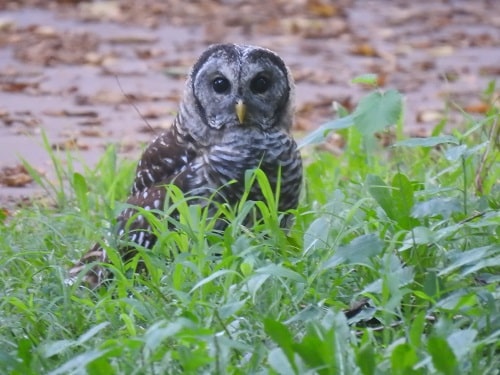Barred Owl Sounds and Calls - Purpose and Meaning
Last updated: September 07, 2025
Barred owls are known for their distinctive calls, sounds, and hoots. Some 13 have been noted, encompassing a range of hoots and screams.
These owl calls serve different purposes and meanings, such as marking territory and courtship of potential mates. Each of the sounds help us to better understand their behaviors.
Here's a detailed overview of the most common barred owl calls, sounds, hoots, and their meanings and purpose.

Hooting Call
Who-cooks-for-you, Who-cooks-for-you-all
This is the classic hooting call of the barred owl. Both males and females give the call, with the females sounding higher in pitch.
While audible throughout the year, this call is most prevalent during the breeding season. Males use it to establish territory and to attract females.
These calls can be heard during both day and night but are more common at dusk and dawn.
Caterwauling or Laughing Call
Another call, sometimes referred to as the caterwaul call or the "laughing" hoot, is a high-energy vocal bout.
It is usually a paired duet with overlapping cackles, hoots, gurgles, yelps, and screams. To listeners it sounds monkey-like.
Heard most during courtship and territorial encounters, though it may occur any time of year.
Screams - Screeching
Barred owls are known for their eerie, haunting screams, which are high-pitched and can be quite startling.
The meaning of these screams are often associated with territory disputes, territorial defense, or aggressive interactions between individuals.
Both males and females can produce these screams. They may also scream when they are captured or injured.
Duets during Breeding Season
During the breeding season, the barred owls courtship calls can be noted in their vocal duets. These calls can be of the main call with the female responding with a series of descending notes.
Or, they may include a mix of the main and what's listed in the courtship and bonding calls below.
Other Courtship Bonding Calls
Cackles: Barred owls sometimes emit a series of cackling sounds, which are often associated with courtship and mating.
These cackles are typically given by both males and females and can be heard during the breeding season.
Whinnies: These owls occasionally produce a whinny-like call, which is a soft, descending series of notes.
Whinnies are often given by males during courtship and are believed to be a way of attracting females
These calls are also used for communication and coordination when hunting, roosting, or feeding.
They are not as loud or distinct as the hooting or screaming calls.
Juvenile Sounds
Begging, Screeches, and Whistles
Juvenile barred owls can produce screeching and whistling calls that are quite different from adult calls.
These calls are used to communicate with their parents and siblings during their early stages of life.
These sounds indicate hunger, distress, or a need for attention from the adult owls. I mostly hear them in the morning giving a raspy call.
Other Sounds You Might Hear
Bill Clicking Barred owls may also produce bill-clicking sounds, which are typically associated with aggressive interactions or when they feel threatened.
Context Dependent
It's important to note that the meaning and intent behind their calls are often context-dependent and can vary based on the situation, such as whether it's related to territorial disputes, mating, or general communication.
This owl species is known to be relatively vocal throughout the year, but their calls are most prominent during the breeding season, which typically occurs from late winter to early spring.
*Resource for number of vocalizations - jstor.org/stable/10.1525/cond.2010.090163
Entities & Sources
- Barred Owl (Strix varia)
- Bird vocalization
- Recordings curated from Xeno-Canto






